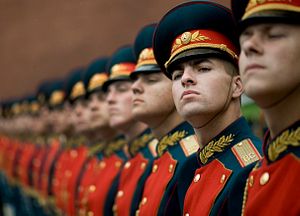Russia’s defense budget will increase by a modest 0.8 percent in 2016, according to information obtained by TASS.
A budget report released by the Defense Committee of the State Duma states that 3.145 trillion rubles ($49 billion) will be allocated for national defense in fiscal year 2016, with a total of 2.233 trillion rubles ($34.8 billion) earmarked for the Russian Armed Forces.
If approved, the defense 2016 defense budget will increase by just 25.5 billion rubles ($400 million), around 0.8 percent, over 2015. It will be the first time since 2011 that Russia’s military expenditure has not increased dramatically.
In 2015, Russia allocated 3.3 trillion rubles (US $52 billion) for defense. However, due to the deteriorating economic outlook, the defense budget had to be cut by five percent to around 3.1 trillion rubles. This nevertheless still constituted a 25.6 percent increase to 2014, according to IHS.
The 0.8 percent hike also appears to be in line with the Russian government’s three-year budget plan adopted in December 2014, which outlined a largely static 2015 defense budget, followed by a 4 percent increase in 2017.
Back in 2010, President Vladimir Putin launched a massive 20 trillion rubles ($700 billion at the time) military modernization project aimed to replace 70 percent of Soviet-era military hardware by 2020, including 50 new warships for the navy, hundreds of new fighter jets and thousands of new vehicles for the ground forces.
The budget draft proposal obtained by TASS did not specify how much of the overall budget will be dedicated to the ongoing modernization programs of the Russian Armed Forces. However, in the past four years, around two-thirds of the total defense budget was dedicated to buying new military equipment. In 2015, around 2 trillion rubles were spent on military procurement.
“[I]n order to meet the targeted level of spending by 2020, further growth of over 10 percent a year in the level of funding for the annual State Defence Order (SDO) would be required from 2016 onwards,” according to IHS defense budget analyst Craig Caffrey.
The Russian military already announced that it would not reduce personnel in 2016. Money for military salaries, in fact, will increase by 40 billion ($640 million). According to The Moscow Times, funds for investment infrastructure “for special and military purposes” will be cut by 48.85 billion rubles ($775 million). Ongoing operations in Ukraine and Syria will also not likely be affected by the static defense budget. (Russia’s deployment to Syria is slated to end in January 2016.)
Despite of the grim economic outlook, Russian President Vladimir Putin is determined to press ahead with his ambitious modernization program (See: “Putin to Press on With Russia’s Military Modernization”), although he did admit in April that certain delays in the modernization program can be expected.
As I reported before, (See: “Is the ‘World’s Deadliest Tank’ Bankrupting Russia?”), Russia, in the long-run, cannot afford military expenditures as seen in 2014 and 2015:
The only way for Russia to currently finance its growing military expenditure is to tap into the country’s reserve fund – money the Kremlin put aside over the last few years when oil prices were high and meant to cushion the economy against shocks. With the help of the reserve fund – worth approximately six percent of the country’s total GDP – Russia could maintain a 3.7 percent [budget] deficit for less than two years(…).
In 2015, Russia’s GDP is projected to decrease by 4.6 percent, largely due to lower oil prices and Western sanctions. Given that Russia’s actual military expenditures in the first three months of 2015 exceeded nine percent of quarterly GDP (rather than the projected 4 to 5 percent), the day when Russia will have to admit that it cannot continue to afford the rapid modernization of its military’s equipment may sooner be upon us than expected.
Despite all of that, most analysts agree that modernization will continue albeit at a slower pace. “[W]hat we may see when the new 2016-2025 [modernization program] is released is that some funding is deferred and back-loaded into the 2020-2025 period,” said Craig Caffrey.

































